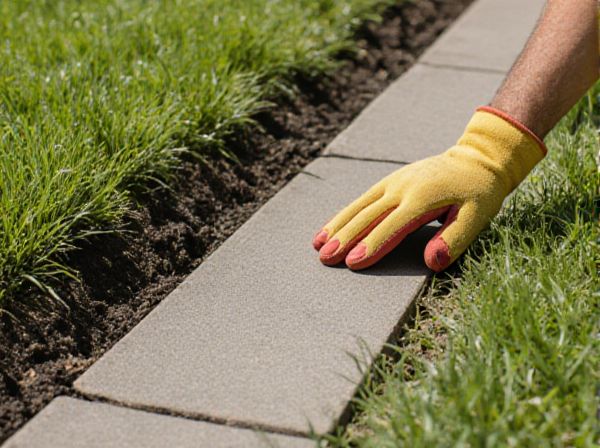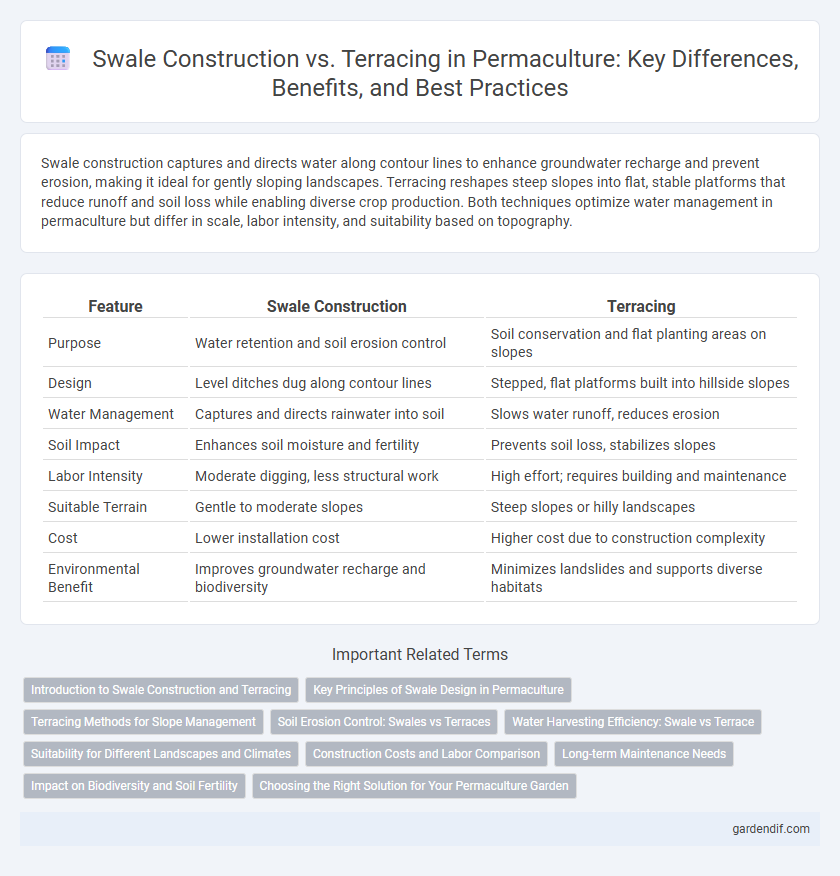
swale construction vs terracing Illustration
Swale construction captures and directs water along contour lines to enhance groundwater recharge and prevent erosion, making it ideal for gently sloping landscapes. Terracing reshapes steep slopes into flat, stable platforms that reduce runoff and soil loss while enabling diverse crop production. Both techniques optimize water management in permaculture but differ in scale, labor intensity, and suitability based on topography.
Table of Comparison
| Feature | Swale Construction | Terracing |
|---|---|---|
| Purpose | Water retention and soil erosion control | Soil conservation and flat planting areas on slopes |
| Design | Level ditches dug along contour lines | Stepped, flat platforms built into hillside slopes |
| Water Management | Captures and directs rainwater into soil | Slows water runoff, reduces erosion |
| Soil Impact | Enhances soil moisture and fertility | Prevents soil loss, stabilizes slopes |
| Labor Intensity | Moderate digging, less structural work | High effort; requires building and maintenance |
| Suitable Terrain | Gentle to moderate slopes | Steep slopes or hilly landscapes |
| Cost | Lower installation cost | Higher cost due to construction complexity |
| Environmental Benefit | Improves groundwater recharge and biodiversity | Minimizes landslides and supports diverse habitats |
Introduction to Swale Construction and Terracing
Swale construction involves creating shallow, water-harvesting ditches on contour lines to slow runoff and increase soil moisture retention, promoting sustainable water management in permaculture landscapes. Terracing reshapes steep slopes into stepped levels for erosion control and maximized arable land, commonly used in hilly or mountainous areas. Both techniques enhance water conservation and soil stability but differ in scale, labor intensity, and adaptability to terrain.
Key Principles of Swale Design in Permaculture
Swale construction in permaculture relies on strategic earthworks to capture and infiltrate water, prioritizing contour-following trenches that slow runoff and promote deep soil hydration. Key principles include precise alignment along elevation contours, adequate sizing to handle specific watershed areas, and incorporation of overflow outlets to prevent erosion. Unlike terracing, swales emphasize passive water management to enhance soil fertility and support diverse plant ecosystems without extensive structural barriers.
Terracing Methods for Slope Management
Terracing methods for slope management involve creating stepped levels on hillsides to reduce soil erosion, improve water retention, and enhance plant growth in permaculture systems. Unlike swale construction, terracing physically reshapes the land to slow water runoff and increase arable surface area, making it ideal for steep slopes prone to erosion. Common terracing techniques include bench terraces, contour terraces, and ribbon terraces, each designed to optimize soil stability and maximize sustainable agricultural productivity on varying gradients.
Soil Erosion Control: Swales vs Terraces
Swales effectively reduce soil erosion by capturing and infiltrating rainwater along contour lines, promoting groundwater recharge and minimizing surface runoff. Terracing controls soil erosion by creating stepped levels that slow water flow and prevent soil displacement on steep slopes. While swales integrate water management with soil conservation in gentle to moderate terrains, terraces are more suitable for steep landscapes requiring structural earthworks to stabilize soil.
Water Harvesting Efficiency: Swale vs Terrace
Swale construction enhances water harvesting efficiency by capturing and infiltrating runoff directly into the soil, reducing erosion and promoting groundwater recharge. Terracing controls water flow on steep slopes by creating flat platforms, which slows runoff but can lead to surface pooling and less infiltration compared to swales. Swales generally provide superior water retention and soil moisture management, making them more effective for sustainable water harvesting in permaculture systems.
Suitability for Different Landscapes and Climates
Swale construction is highly effective in gently sloping landscapes and regions with moderate to high rainfall, as it captures and infiltrates water efficiently, reducing erosion and enhancing soil moisture. Terracing suits steeper slopes and areas with varying rainfall patterns by creating flat planting surfaces that prevent soil loss and maximize arable land. Both techniques support sustainable water management but are selected based on topography and climate conditions for optimal permaculture design.
Construction Costs and Labor Comparison
Swale construction typically incurs lower costs and requires less labor compared to terracing due to simpler earth-moving techniques and minimal structural reinforcement. Terracing demands more intensive labor and higher expenses for building retaining walls or steps to prevent soil erosion on steep slopes. Choosing swales can optimize budget and labor efficiency in permaculture projects focused on water management and soil conservation.
Long-term Maintenance Needs
Swale construction requires minimal long-term maintenance due to its passive water management design, which reduces soil erosion and enhances groundwater recharge without constant intervention. Terracing demands regular upkeep such as repairing retaining walls, managing runoff channels, and preventing soil degradation to maintain structural integrity and effectiveness. Choosing swales over terracing often lowers ongoing labor and resource inputs, making swales a more sustainable option for long-term permaculture land management.
Impact on Biodiversity and Soil Fertility
Swale construction enhances biodiversity by creating microhabitats that support diverse plant and animal species through improved water retention and soil moisture. Terracing primarily focuses on erosion control and crop production but can limit habitat diversity due to its uniform structure and soil disturbance. Swales maintain soil fertility by reducing runoff and promoting nutrient infiltration, whereas terracing can sometimes lead to soil compaction and nutrient depletion if not managed properly.
Choosing the Right Solution for Your Permaculture Garden
Swale construction in permaculture captures and channels rainwater efficiently by creating contour-aligned ditches that reduce soil erosion and increase infiltration. Terracing, on the other hand, involves building stepped levels on slopes to prevent runoff and maximize arable land by creating flat planting areas. Selecting the right solution depends on your garden's slope, soil type, and water management goals to optimize sustainability and productivity.
swale construction vs terracing Infographic

 gardendif.com
gardendif.com